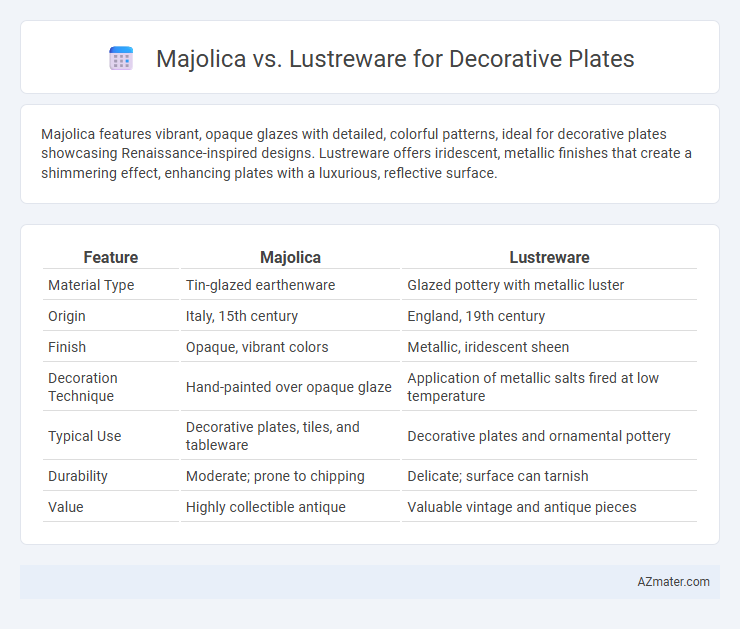Majolica features vibrant, opaque glazes with detailed, colorful patterns, ideal for decorative plates showcasing Renaissance-inspired designs. Lustreware offers iridescent, metallic finishes that create a shimmering effect, enhancing plates with a luxurious, reflective surface.
Table of Comparison
| Feature | Majolica | Lustreware |
|---|---|---|
| Material Type | Tin-glazed earthenware | Glazed pottery with metallic luster |
| Origin | Italy, 15th century | England, 19th century |
| Finish | Opaque, vibrant colors | Metallic, iridescent sheen |
| Decoration Technique | Hand-painted over opaque glaze | Application of metallic salts fired at low temperature |
| Typical Use | Decorative plates, tiles, and tableware | Decorative plates and ornamental pottery |
| Durability | Moderate; prone to chipping | Delicate; surface can tarnish |
| Value | Highly collectible antique | Valuable vintage and antique pieces |
Introduction to Majolica and Lustreware
Majolica is a type of tin-glazed pottery originating from the Renaissance period, characterized by its vibrant colors and intricate hand-painted designs on a white background. Lustreware, known for its iridescent metallic sheen, is created by applying a metallic glaze that reflects light, producing a shimmering effect. Both techniques offer unique decorative qualities that enhance the aesthetic appeal of collectible plates.
Historical Origins of Majolica
Majolica originated in the Renaissance period, specifically during the 15th century in Italy, as tin-glazed pottery characterized by vibrant, colorful designs and a white opaque glaze that serves as a canvas for intricate hand-painted patterns. This technique was inspired by earlier Islamic ceramics and later spread across Europe, evolving into regional styles unique to places like Spain and England. In contrast, Lustreware emerged slightly later, noted for its metallic iridescent glaze achieved through an additional firing process, making Majolica culturally significant for its vivid decorative artistry and historical influence on European ceramics.
The Evolution of Lustreware
Lustreware, originating in the early 19th century, evolved from traditional Majolica techniques by incorporating metallic oxides to create its distinctive iridescent finish on decorative plates. Unlike Majolica's brightly colored, opaque glazes, Lustreware's shimmering surface reflects light with a pearlescent effect achieved through a complex firing process. This advancement marked a significant innovation in ceramic decoration, influencing decorative arts with its unique combination of chemistry and artistry.
Distinctive Artistic Techniques Compared
Majolica features a tin-glazed earthenware technique that creates a vibrant, opaque white surface ideal for detailed hand-painted designs, often showcasing floral and narrative motifs with rich, glossy colors. Lustreware distinguishes itself by applying metallic oxides over a glazed surface, resulting in an iridescent, shimmering finish that reflects light and gives plates a unique, reflective sheen. The contrast between Majolica's vivid, matte-like underglaze palette and Lustreware's lustrous, metallic overlay highlights their distinctive artistic approaches in decorative plate production.
Color Palettes and Glazing Differences
Majolica decorative plates feature vibrant, opaque color palettes with intricate hand-painted designs made using lead-based tin glazes that create a glossy, textured surface. Lustreware plates showcase iridescent, metallic hues achieved through a thin layer of metallic oxides applied over a transparent glaze, resulting in a shimmering, reflective finish. The glazing method in majolica emphasizes bright, solid colors and a tactile feel, while lustreware glazing prioritizes a delicate, luminous sheen that changes with light angles.
Cultural Influences on Decorative Plate Design
Majolica decorative plates showcase vibrant, tin-glazed earthenware influenced by Italian Renaissance artistry and Spanish-Moorish patterns, highlighting floral and narrative motifs rich in historical symbolism. Lustreware plates exhibit metallic iridescence rooted in Middle Eastern and Islamic ceramics, reflecting cultural exchanges through trade routes that introduced metallic glaze techniques to European artisans. The distinct cultural origins of Majolica and Lustreware deeply inform their decorative aesthetics, materials, and glazing methods, embodying diverse artistic traditions on functional art pieces.
Durability and Functional Qualities
Majolica decorative plates are known for their vibrant, tin-glazed surface that provides moderate durability but may be prone to chipping due to its porous nature. Lustreware, featuring a metallic glaze made from silver or copper oxides, offers enhanced durability and a more resistant surface that withstands everyday use better than traditional Majolica. Both types serve decorative purposes well, but Lustreware's resilient finish makes it more suitable for functional use where durability is a priority.
Collectibility and Market Value
Majolica decorative plates, characterized by their vibrant, tin-glazed earthenware and intricate hand-painted designs, often command higher market value due to their historical significance and craftsmanship, making them highly collectible among antique enthusiasts. Lustreware plates, noted for their iridescent metallic glaze achieved through a special firing process, appeal to collectors interested in unique surface effects but typically hold a more niche collectibility and moderate market value. Rarity, condition, and provenance significantly influence the collectibility and price of both Majolica and Lustreware decorative plates in the antiques market.
Choosing Between Majolica and Lustreware for Decor
Majolica and Lustreware each offer unique decorative qualities for plates, with Majolica known for its vibrant, hand-painted tin glaze and intricate, nature-inspired designs, while Lustreware features a distinctive metallic sheen created by a lustrous oxide glaze. When choosing between the two, consider Majolica's rich color palette and traditional craftsmanship, ideal for rustic or classic decor themes, whereas Lustreware's reflective surface and Art Deco influences suit modern or eclectic interiors. Durability and maintenance also differ; Majolica's opaque glaze tends to be more resistant to chipping, while Lustreware requires careful handling to preserve its lustrous finish.
Care and Display Tips for Decorative Plates
Majolica decorative plates, with their vibrant tin-glazed surfaces, require gentle cleaning using a soft, damp cloth to preserve the colorful, intricate designs and prevent damage to the glaze. Lustreware plates, known for their iridescent metallic sheen, should be handled with care, avoiding abrasive materials and harsh chemicals that can dull the delicate finish. Display both types in stable, dust-free environments away from direct sunlight to prevent fading and maintain their visual appeal over time.

Infographic: Majolica vs Lustreware for Decorative Plate
 azmater.com
azmater.com